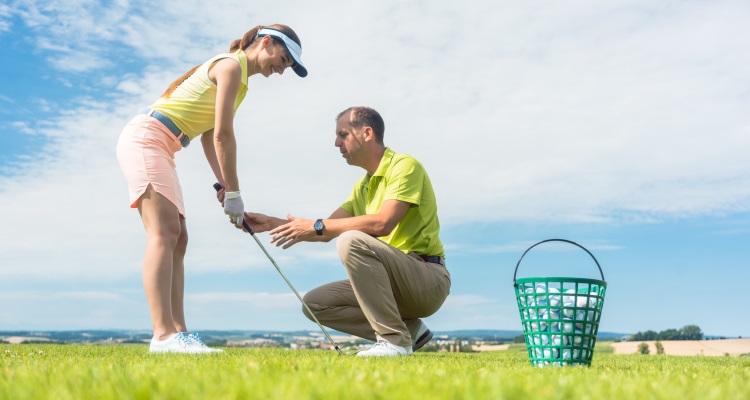Learning to play golf can be quite intimidating, but the good news is that with a little time, effort and the proper instruction, you can learn the skills you need that will benefit you now and for years to come. It is a good idea to take lessons right from the start. In many cases, you can just sign up and go. You may not even have to have a set of golf clubs, since many golf instructors supply them for beginners. The important thing is to dress appropriately, learn the basics and then get out on the driving range and practice.
Signing Up for Lessons
A good way to begin golfing is to take a series of group lessons. There are several advantages to taking group lessons rather than private lessons as a beginner. First of all, group lessons are generally less expensive than individual lessons. The key is to find a Professional Golf Association (PGA) teaching pro to instruct you. Once you find the right teacher, you may find it more comfortable and motivating to learn with several others who are on your level. As an added bonus, your fellow students may become your golfing buddies when you are ready to go out on the links. After you learn the basics, individual one-on-one lessons can help you improve your accuracy and distance.
Dressing Appropriately
Be prepared when you show up for your golf lessons. If you do not have golf clothes, wear comfortable shorts and a collared shirt for men, and shorts or a “skort” for women. Sneakers are fine for beginners if you did not buy your golf shoes yet. Remember that you will be outdoors for over an hour, so put on sunscreen and be sure to wear a hat to protect your skin. You may also want to carry a bottle of water with you. Also, bring along a notebook to jot down the main points you learned in the lesson. This is important even if the golf pro supplies you with notes, because you will be putting the key elements of the lesson down on paper in your own words.
Learning the Clubs
Your golf professional will explain the difference between the various clubs and how they are used. If you have ever visited a golf store, you know that there are many options out there. The main thing is to understand the comparison between a driver, hybrids, irons and the putter. Eventually you will need to use a variety of clubs, but for beginning lessons the pro will probably start you out with a lofted iron like a 9-or an 8-iron, which is easier to hit than others clubs. Once you develop a swing, the teaching pro can recommend clubs for you based on your needs.
Playing by the Rules
The official Rules of Golf are published by the United States Golf Association (USGA) on a regular basis to keep up with changes in the rules. Your golf pro may go over some of the basic rules, like who hits first and what to do if your ball flies into a water hazard. Golf etiquette covers such issues as showing consideration for other players, how to behave on the putting green, keeping up with the pace of play and being ready to play when it is your turn. Some of these rules may be unspoken, and others may be covered by the rules of the golf course.
Swinging the Club
Beginning golfers will learn the proper grip, stance and swing to produce an effective golf shot. Keep in mind that a small correction can make a big difference. Your pro will probably tell you to relax when you grip the club and adopt a balanced stance with your weight distributed equally over your right and left leg. Some golfers do the “waggle” by wiggling their rear slightly to get a feel for their stance. You will then start the takeaway by making a shoulder turn to build torque and continue the backswing until the club is at a 90 degree angle to your left arm with your wrists cocked. For the downswing, you will turn your belt buckle toward the target as fast as possible when you get half way through the motion.
Getting Out to Play
After taking lessons, making notes and practicing, the best thing to do is to get out on the course and play. If possible, go out with a more experienced player at first to learn the ropes. To play with a low handicap golfer, try using the “best ball” format so you do not slow the better player down. Simply hit your ball, and then place it next to your partner’s ball and hit the next shot. The only thing left to do is to enjoy the day.


